Surfactant-Enhanced Solubilization of Chlorinated Organic Compounds Contained in DNAPL from Lindane Waste: Effect of Surfactant Type and pH
Abstract
1. Introduction
2. Materials and Methods
2.1. Chemicals
2.2. Solubility Experiments
2.3. Analytical Methods
3. Results and Discussions
3.1. Partitioning of a Surfactant under Equilibrium Conditions
3.2. Solubilization of COCs
3.2.1. Distribution of Solubilized COCs
3.2.2. Partition Equilibria of Solubilized COCs
WSR = (∑Cj,AQ)eq/(Csurf,AQ)eq,
4. Conclusions
Supplementary Materials
Author Contributions
Funding
Acknowledgments
Conflicts of Interest
References
- van Liedekerke, M.; Prokop, G.; Rabl-Berger, S.; Kibblewhite, M.; Louwagie, G. Progress in the Management of Contaminated Sites in Europe; Reference Report; Joint Research Centre of The European Union: Ispra, Italy, 2014. [Google Scholar]
- Siegrist, R.L.; Crimi, M.; Simpkin, T.J. Situ Chemical Oxidation for Groundwater Remediation; Springer: New York, NY, USA, 2011. [Google Scholar] [CrossRef]
- Sulaymon, A.H.; Gzar, H.A. Experimental investigation and numerical modeling of light nonaqueous phase liquid dissolution and transport in a saturated zone of the soil. J. Hazard. Mater. 2011, 186, 1601–1614. [Google Scholar] [CrossRef] [PubMed]
- Soga, K.; Page, J.W.; Illangasekare, T.H. A review of NAPL source zone remediation efficiency and the mass flux approach. J. Hazard. Mater. 2004, 110, 13–27. [Google Scholar] [CrossRef] [PubMed]
- Parker, B.L.; Bairos, K.; Maldaner, C.H.; Chapman, S.W.; Turner, C.M.; Burns, L.S.; Plett, J.; Carter, R.; Cherry, J.A. Metolachlor dense non-aqueous phase liquid source conditions and plume attenuation in a dolostone water supply aquifer. In Groundwater in Fractured Bedrock Environments: Managing Catchment and Subsurface Resources; Ofterdinger, U., Macdonald, A.M., Comte, J.C., Young, M.E., Eds.; Geological Sociaty of London: London, UK, 2019; Volume 479, pp. 207–236. [Google Scholar]
- Santos, A.; Fernandez, J.; Guadano, J.; Lorenzo, D.; Romero, A. Chlorinated organic compounds in liquid wastes (DNAPL) from lindane production dumped in landfills in Sabinanigo (Spain). Environ. Poll. 2018, 242, 1616–1624. [Google Scholar] [CrossRef] [PubMed]
- Fernández, J.; Arjol, M.; Cacho, C. POP-contaminated sites from HCH production in Sabiñánigo, Spain. Environ. Sci. Pollut. Res. 2013, 20, 1937–1950. [Google Scholar] [CrossRef] [PubMed]
- Council, N.R. Alternatives for Managing the Nation’s Complex Contaminated Groundwater Sites; National Academies Press: Washington, DC, USA, 2013. [Google Scholar]
- Agaoglu, B.; Copty, N.K.; Scheytt, T.; Hinkelmann, R. Interphase mass transfer between fluids in subsurface formations: A review. Adv. Water Resour. 2015, 79, 162–194. [Google Scholar] [CrossRef]
- Brusseau, M.L. The Impact of DNAPL Source-Zone Architecture on Contaminant Mass Flux and Plume Evolution in Heterogeneous Porous Media; ARIZONA UNIV TUCSON: Tucson, AZ, USA, 2013. [Google Scholar]
- Schaefer, C.E.; White, E.B.; Lavorgna, G.M.; Annable, M.D. Dense Nonaqueous-Phase Liquid Architecture in Fractured Bedrock: Implications for Treatment and Plume Longevity. Environ. Sci. Technol. 2016, 50, 207–213. [Google Scholar] [CrossRef]
- Kavanaugh, M.C.; Suresh, P.; Rao, C. The DNAPL Remediation Challenge: Is there a Case for Source Depletion; Environmental Protection Agency: Washington, DC, USA, 2003. [Google Scholar]
- McGuire, T.M.; McDade, J.M.; Newell, C.J. Performance of DNAPL source depletion technologies at 59 chlorinated solvent—Impacted sites. Groundw. Monit. Remediat. 2006, 26, 73–84. [Google Scholar] [CrossRef]
- Atteia, O.; Estrada, E.D.; Bertin, H. Soil flushing: A review of the origin of efficiency variability. Rev. Environ. Sci. Bio. Technol. 2013, 12, 379–389. [Google Scholar] [CrossRef]
- Strbak, L. Situ Flushing with Surfactants and Cosolvents; National Network of Environmental Studies Fellowship Report for US Environmental Protection Agency; Office of Solid Waste and Emergency Response Technology Innovation Office: Washington, DC, USA, 2000. [Google Scholar]
- Svab, M.; Kubala, M.; Muellerova, M.; Raschman, R. Soil flushing by surfactant solution: Pilot-scale demonstration of complete technology. J. Hazard. Mater. 2009, 163, 410–417. [Google Scholar] [CrossRef]
- Pennell, K.D.; Capiro, N.L.; Walker, D.I. Surfactant and cosolvent flushing. In Chlorinated Solvent Source Zone Remediation; Kueper, B.H., Stroo, H.F., Vogel, C.M., Ward, C.H., Eds.; Springer: New York, NY, USA, 2014; Volume 7, pp. 353–394. [Google Scholar]
- Maire, J.; Joubert, A.; Kaifas, D.; Invernizzi, T.; Marduel, J.; Colombano, S.; Cazaux, D.; Marion, C.; Klein, P.Y.; Dumestre, A.; et al. Assessment of flushing methods for the removal of heavy chlorinated compounds DNAPL in an alluvial aquifer. Sci. Total Environ. 2018, 612, 1149–1158. [Google Scholar] [CrossRef]
- Londergan, J.; Yeh, L. Surfactant-Enhanced Aquifer Remediation (SEAR) Implementation Manual; INTERA INC.: Austin, TX, USA, 2003. [Google Scholar]
- Acosta, E.J.; Quraishi, S. Surfactant Technologies for Remediation of Oil Spills. In Oil Spill Remediation: Colloid Chemistry-Based Principles and Solutions; Somasundaran, P., Patra, P., Farinato, R.S., Papadopoulos, K., Eds.; Wiley & Sons: Hoboken, NJ, USA, 2014; pp. 317–358. [Google Scholar]
- Mulligan, C.; Yong, R.; Gibbs, B. Surfactant-enhanced remediation of contaminated soil: A review. Eng. Geol. 2001, 60, 371–380. [Google Scholar] [CrossRef]
- Besha, A.T.; Bekele, D.N.; Naidu, R.; Chadalavada, S. Recent advances in surfactant-enhanced In-Situ Chemical Oxidation for the remediation of non-aqueous phase liquid contaminated soils and aquifers. Environ. Technol. Innov. 2018, 9, 303–322. [Google Scholar] [CrossRef]
- Rosen, M.J.; Kunjappu, J.T. Surfactants and Interfacial Phenomena; John Wiley & Sons: Hoboken, NJ, USA, 2012. [Google Scholar]
- Mukerjee, P.; Mysels, K.J. Critical Micelle Concentrations of Aqueous Surfactant Systems; National Standard Reference Data system: Washington, DC, USA, 1971. [Google Scholar]
- Mao, X.; Jiang, R.; Xiao, W.; Yu, J. Use of surfactants for the remediation of contaminated soils: A review. J. Hazard. Mater. 2015, 285, 419–435. [Google Scholar] [CrossRef]
- Swe, M.M.; Yu, L.Y.E.; Hung, K.C.; Chen, B.H. Solubilization of selected polycyclic aromatic compounds by nonionic surfactants. J. Surfactants Deterg. 2006, 9, 237–244. [Google Scholar] [CrossRef]
- Bouzid, I.; Maire, J.; Brunol, E.; Caradec, S.; Fatin-Rouge, N. Compatibility of surfactants with activated-persulfate for the selective oxidation of PAH in groundwater remediation. J. Environ. Chem. Eng. 2017, 5, 6098–6106. [Google Scholar] [CrossRef]
- Sharmin, R.; Ioannidis, M.A.; Legge, R.L. Effect of nonionic surfactant partitioning on the dissolution kinetics of residual perchloroethylene in a model porous medium. J. Contam. Hydrol. 2006, 82, 145–164. [Google Scholar] [CrossRef] [PubMed]
- Kibbey, T.C.G.; Chen, L.C. Phase volume effects in the sub- and super-CMC partitioning of nonionic surfactant mixtures between water and immiscible organic liquids. Colloid Surf. A 2008, 326, 73–82. [Google Scholar] [CrossRef]
- Zimmerman, J.B.; Kibbey, T.C.G.; Cowell, M.A.; Hayes, K.F. Partitioning of ethoxylated nonionic surfactants into nonaqueous-phase organic liquids: Influence on solubilization behavior. Environ. Sci. Technol. 1999, 33, 169–176. [Google Scholar] [CrossRef]
- Kang, S.; Lim, H.S.; Gao, Y.; Kang, J.; Jeong, H.Y. Evaluation of ethoxylated nonionic surfactants for solubilization of chlorinated organic phases: Effects of partitioning loss and macroemulsion formation. J. Contam. Hydrol. 2019, 223, 103475. [Google Scholar] [CrossRef]
- Paria, S. Surfactant-enhanced remediation of organic contaminated soil and water. Adv. Colloid Interface Sci. 2008, 138, 24–58. [Google Scholar] [CrossRef]
- Muff, J.; MacKinnon, L.; Durant, N.D.; Bennedsen, L.F.; Rugge, K.; Bondgaard, M.; Pennell, K.D. Solubility and reactivity of surfactant-enhanced alkaline hydrolysis of organophosphorus pesticide DNAPL. Environ. Sci. Pollut. Res. 2020, 27, 3428–3439. [Google Scholar] [CrossRef] [PubMed]
- West, C.C.; Harwell, J.H. Surfactants and subsurface remediation. Environ. Sci. Technol. 1992, 26, 2324–2330. [Google Scholar] [CrossRef]
- Babaei, M.; Copty, N.K. Numerical modelling of the impact of surfactant partitioning on surfactant-enhanced aquifer remediation. J. Contam. Hydrol. 2019, 221, 69–81. [Google Scholar] [CrossRef] [PubMed]
- Cowell, M.A.; Kibbey, T.C.G.; Zimmerman, J.B.; Hayes, K.F. Partitioning of ethoxylated nonionic surfactants in water/NAPL systems: Effects of surfactant and NAPL properties. Environ. Sci. Technol. 2000, 34, 1583–1588. [Google Scholar] [CrossRef]
- Yang, J.-S.; Yang, J.-W. Partitioning effects of nonionic surfactants on the solubilization of single or binary chlorinated solvents: Batch and column experiments. J. Ind. Eng. Chem. 2018, 58, 140–147. [Google Scholar] [CrossRef]
- Catanoiu, G.; Carey, E.; Patil, S.R.; Engelskirchen, S.; Stubenrauch, C. Partition coefficients of nonionic surfactants in water/n-alkane systems. J. Colloid Interface Sci. 2011, 355, 150–156. [Google Scholar] [CrossRef]
- Lorenzo, D.; García-Cervilla, R.; Romero, A.; Santos, A. Partitioning of chlorinated organic compounds from dense non-aqueous phase liquids and contaminated soils from lindane production wastes to the aqueous phase. Chemosphere 2020, 239, 124798. [Google Scholar] [CrossRef]
- Casado, I.; Mahjoub, H.; Lovera, R.; Fernandez, J.; Casas, A. Use of electrical tomography methods to determinate the extension and main migration routes of uncontrolled landfill leachates in fractured areas. Sci. Total Environ. 2015, 506, 546–553. [Google Scholar] [CrossRef]
- Navarro, J.S.; López, C.; García, A.P. Characterization of groundwater flow in the Bailin hazardous waste-disposal site (Huesca, Spain). Environ. Geol. 2000, 40, 216–222. [Google Scholar] [CrossRef]
- Rhue, R.D.; Rao, P.S.C.; Annable, M.D. Single-phase microemulsification of a complex light-nonaqueous-phase-liquid: Laboratory evaluation of several mixtures of surfactant alcohol solutions. J. Environ. Qual. 1999, 28, 1135–1144. [Google Scholar] [CrossRef]
- Cheng, M.; Zeng, G.; Huang, D.; Yang, C.; Lai, C.; Zhang, C.; Liu, Y. Advantages and challenges of Tween 80 surfactant-enhanced technologies for the remediation of soils contaminated with hydrophobic organic compounds. Chem. Eng. J. 2017, 314, 98–113. [Google Scholar] [CrossRef]
- Franzetti, A.; Di Gennaro, P.; Bevilacqua, A.; Papacchini, M.; Bestetti, G. Environmental features of two commercial surfactants widely used in soil remediation. Chemosphere 2006, 62, 1474–1480. [Google Scholar] [CrossRef] [PubMed]
- Muherei, M.A.; Junin, R.; Bin Merdhah, A.B. Adsorption of sodium dodecyl sulfate, Triton X100 and their mixtures to shale and sandstone: A comparative study. J. Pet. Sci. Eng. 2009, 67, 149–154. [Google Scholar] [CrossRef]
- Corcho, D.; Fernández, J.; Laperou, L.; Guadaño, J. Laboratory evaluation of mixed surfactants solutions to mobilise hexachlorocyclohexane (DNAPL) from sardas landfill (Aragón, Spain). In Proceedings of the 13th HCH & Pesticides Forum, Zaragoza, Spain, 3–6 Novermber 2015. [Google Scholar]
- Tsaboula, A.; Papadakis, E.-N.; Vryzas, Z.; Kotopoulou, A.; Kintzikoglou, K.; Papadopoulou-Mourkidou, E. Environmental and human risk hierarchy of pesticides: A prioritization method, based on monitoring, hazard assessment and environmental fate. Environ. Int. 2016, 91, 78–93. [Google Scholar] [CrossRef]
- Willett, K.L.; Ulrich, E.M.; Hites, R.A. Differential toxicity and environmental fates of hexachlorocyclohexane isomers. Environ. Sci. Technol. 1998, 32, 2197–2207. [Google Scholar] [CrossRef]
- Tsai, K.-P.; Chen, C.-Y. An algal toxicity database of organic toxicants derived by a closed-system technique. Environ. Toxicol. Chem. 2007, 26, 1931–1939. [Google Scholar] [CrossRef]
- van Wijk, D.; Cohet, E.; Gard, A.; Caspers, N.; van Ginkel, C.; Thompson, R.; de Rooij, C.; Garny, V.; Lecloux, A. 1,2,4-Trichlorobenzene marine risk assessment with special emphasis on the Osparcom region North Sea. Chemosphere 2006, 62, 1294–1310. [Google Scholar] [CrossRef]
- Zhou, M.F.; Rhue, R.D. Screening commercial surfactants suitable for remediating DNAPL source zones by solubilization. Environ. Sci. Technol. 2000, 34, 1985–1990. [Google Scholar] [CrossRef]
- Pei, G.P.; Zhu, Y.E.; Cai, X.T.; Shi, W.Y.; Li, H. Surfactant flushing remediation of o-dichlorobenzene and p-dichlorobenzene contaminated soil. Chemosphere 2017, 185, 1112–1121. [Google Scholar] [CrossRef]
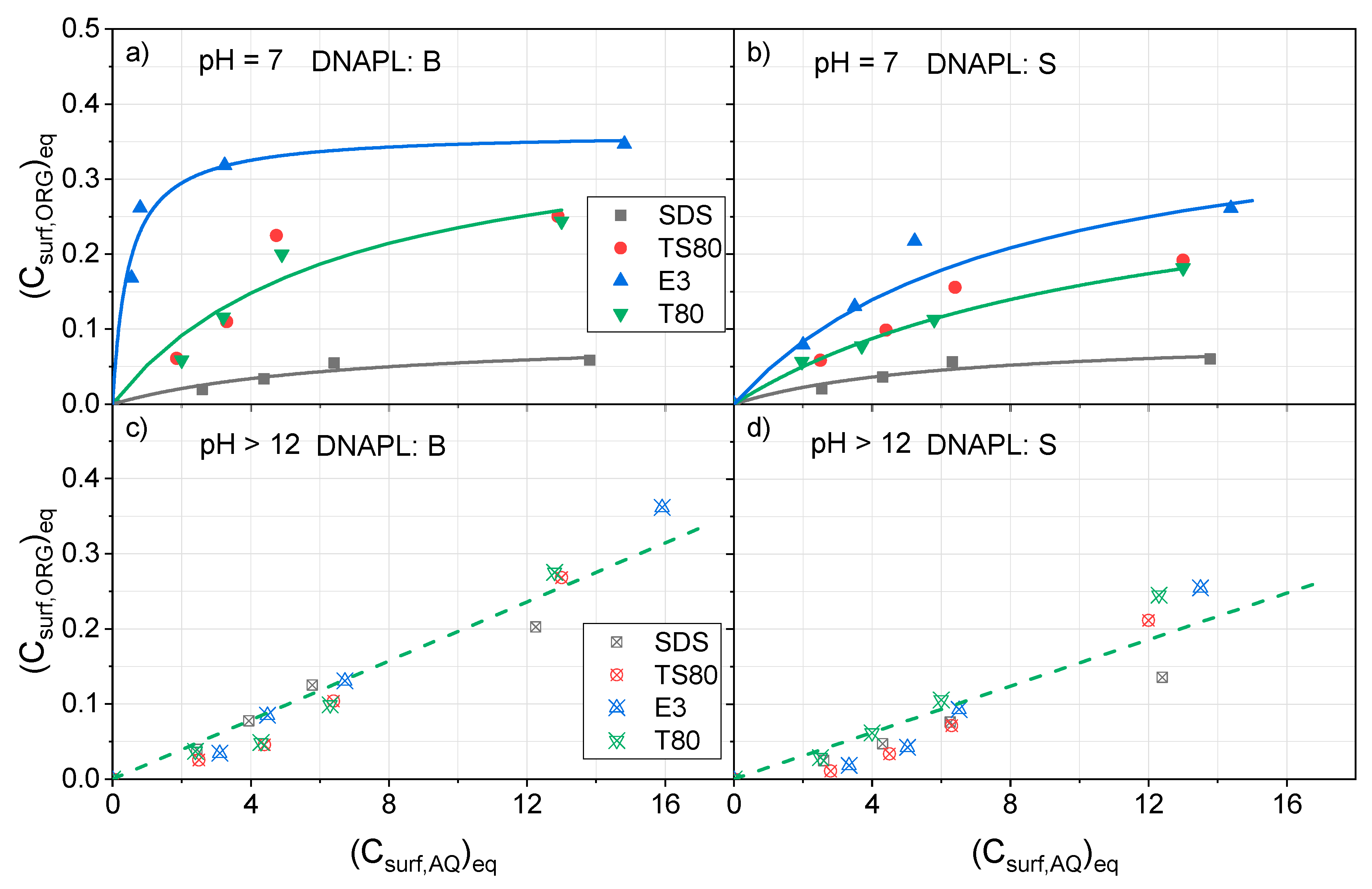
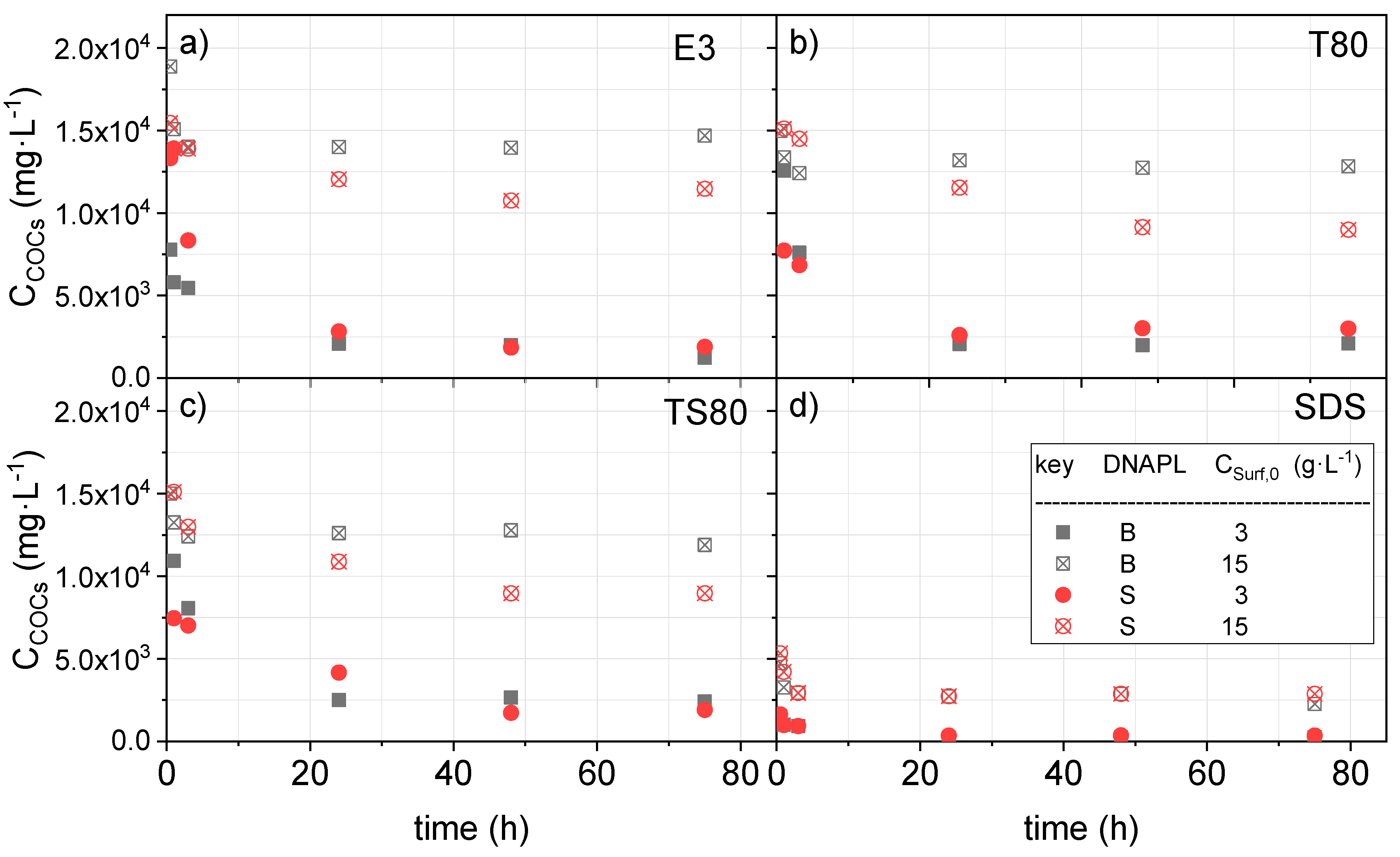
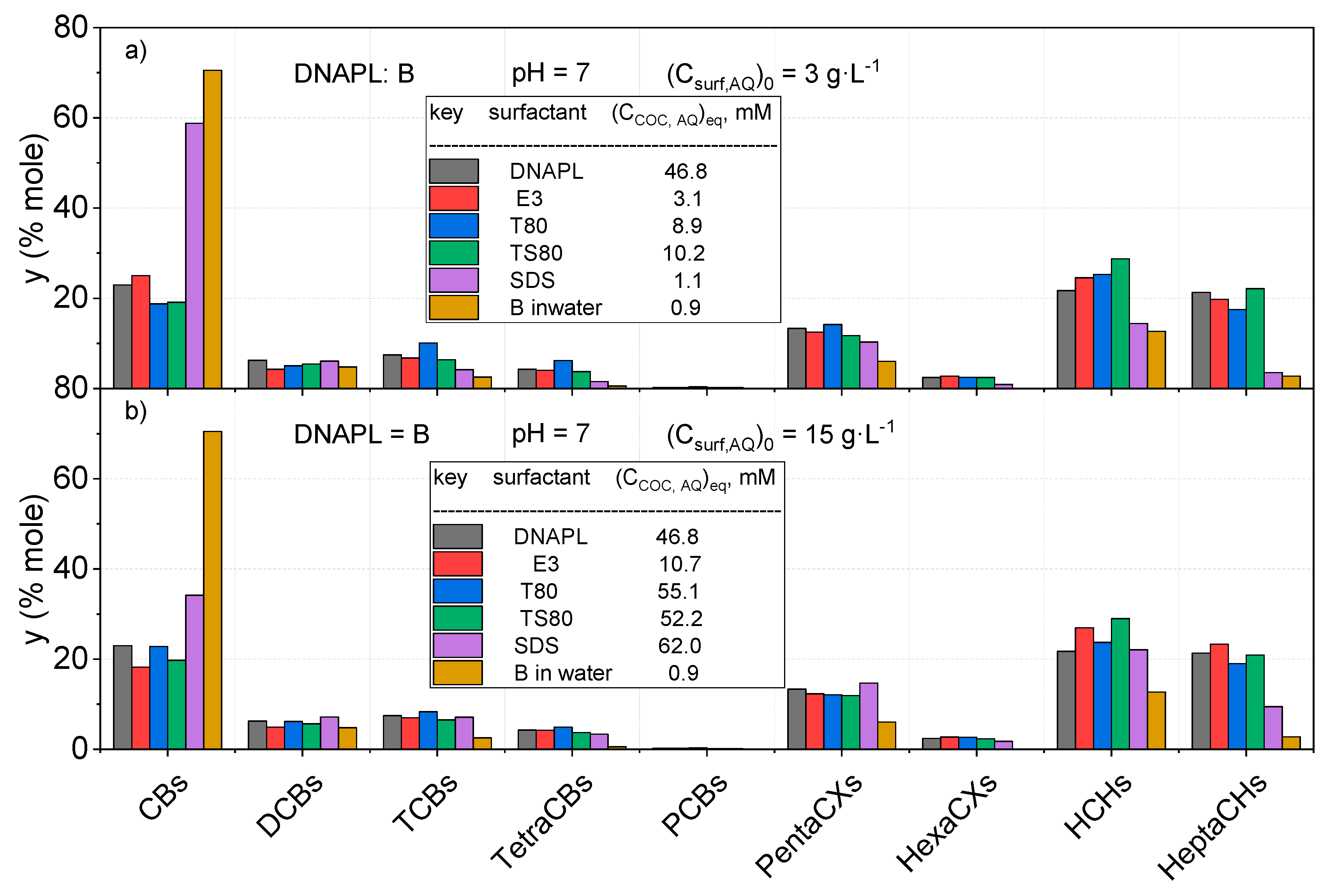
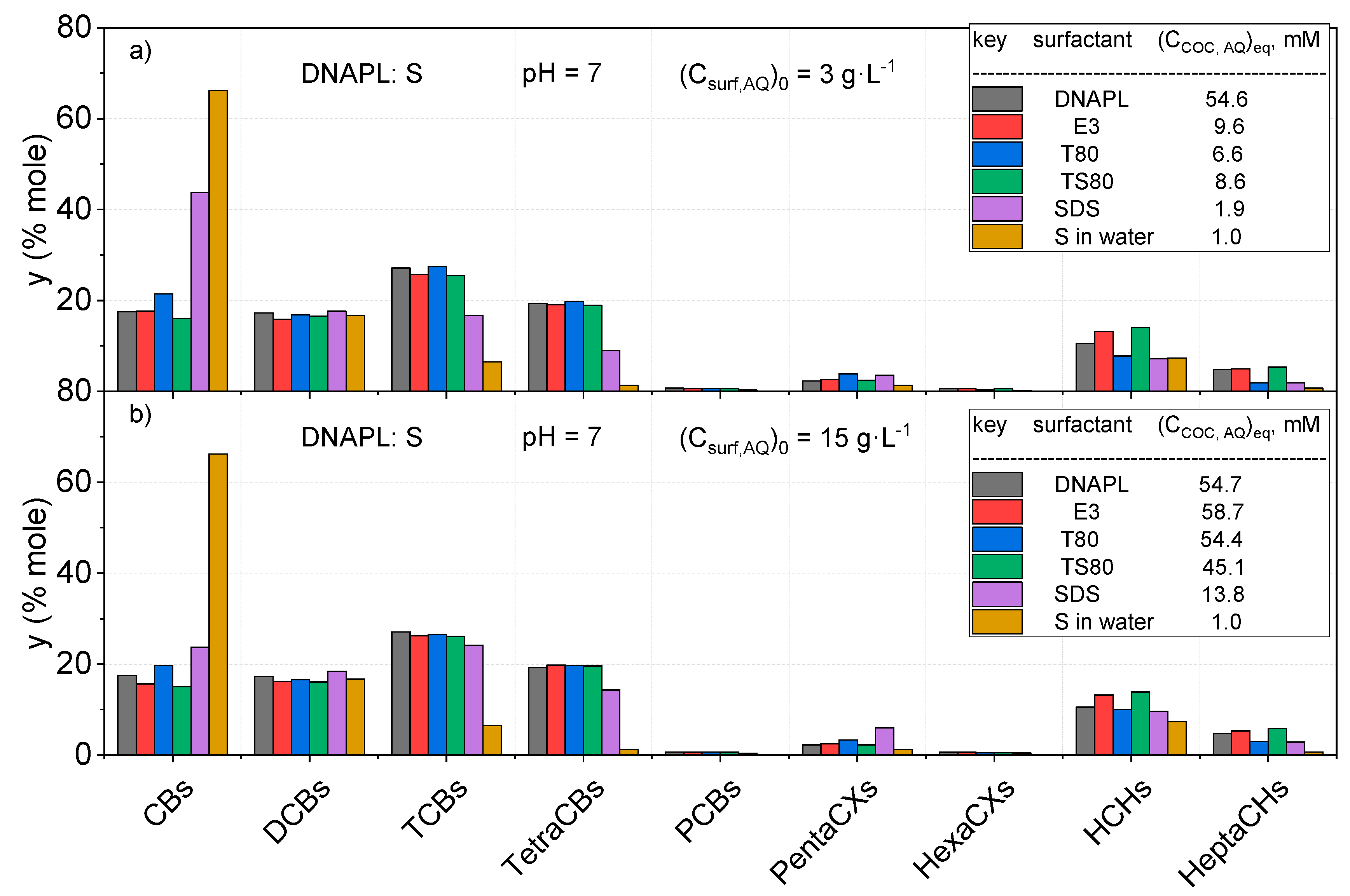
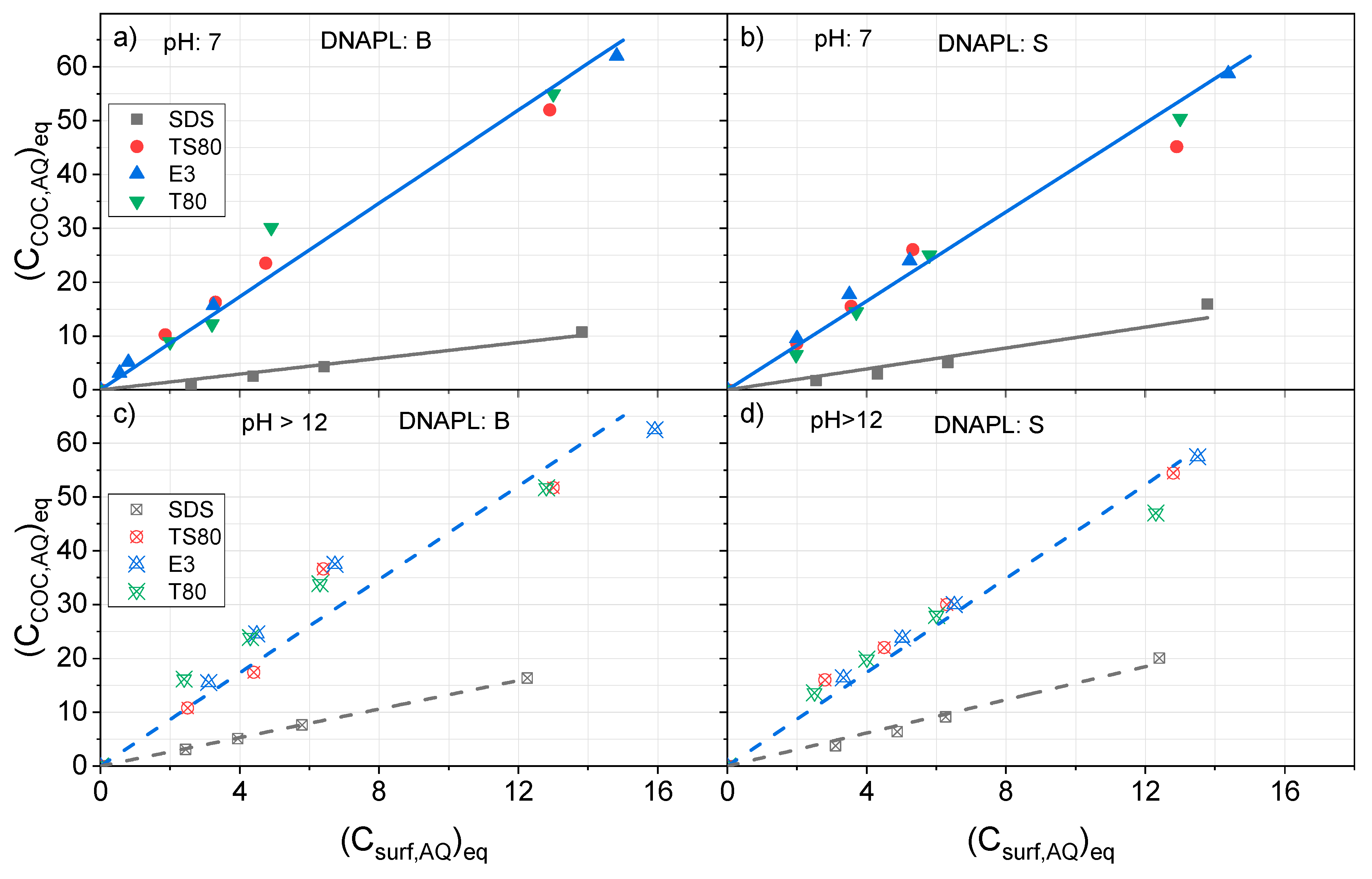
| pH = 7 | pH = 7 | |||||
| DNAPL: B | DNAPL: S | |||||
| Surf. | Cs,ORG gsurf·g−1ORG | KS L·g−1surf | KL gsurf,ORG·L·g−1surf·g−1ORG | Cs,ORG gsurf·g−1ORG | KS L·g−1surf | KL gsurf,ORG·L·g−1surf·g−1ORG |
| SDS | 0.093 | 0.143 | 0.013 | 0.093 | 0.159 | 0.015 |
| T80 and TS80 | 0.387 | 0.155 | 0.059 | 0.354 | 0.097 | 0.034 |
| E3 | 0.362 | 2.179 | 0.789 | 0.415 | 0.126 | 0.052 |
| pH > 12 | pH > 12 | |||||
| Cs,ORG gsurf·g−1ORG | KS L·g−1surf | KL gsurf,ORG·L·g−1surf·g−1ORG | Cs,ORG gsurf·g−1ORG | KS L·g−1surf | KL gsurf,ORG·L·g−1surf·g−1ORG | |
| All | 0.020 | 0.016 | ||||
| Nonionic Surfactants pH = 7 and >12, DNAPL: B and S | |||
| WSR mgCOCs·g−1surf | MSR MWS mmolCOCs·g−1surf | MSR mmolCOCs·mmol−1surf | |
| T80 | 5.66 | ||
| TS80 | 1005 | 4.33 | 3.11 |
| E3 | - | ||
| Anionic surfactant: SDS surfactant | |||
| WSR mgCOCs·g−1surf | MSR MWS mmolCOCs·g−1surf | MSR mmolCOCs·mmol−1surf | |
| pH = 7 DNAPL: B | 162 | 0.7 | 0.43 |
| pH = 7 DNAPL: S | 186 | 0.97 | 0.68 |
| pH > 12 DNAPL: B | 307 | 1.32 | 0.8 |
| pH > 12 DNAPL: S | 295 | 1.54 | 0.94 |
© 2020 by the authors. Licensee MDPI, Basel, Switzerland. This article is an open access article distributed under the terms and conditions of the Creative Commons Attribution (CC BY) license (http://creativecommons.org/licenses/by/4.0/).
Share and Cite
García-Cervilla, R.; Romero, A.; Santos, A.; Lorenzo, D. Surfactant-Enhanced Solubilization of Chlorinated Organic Compounds Contained in DNAPL from Lindane Waste: Effect of Surfactant Type and pH. Int. J. Environ. Res. Public Health 2020, 17, 4494. https://doi.org/10.3390/ijerph17124494
García-Cervilla R, Romero A, Santos A, Lorenzo D. Surfactant-Enhanced Solubilization of Chlorinated Organic Compounds Contained in DNAPL from Lindane Waste: Effect of Surfactant Type and pH. International Journal of Environmental Research and Public Health. 2020; 17(12):4494. https://doi.org/10.3390/ijerph17124494
Chicago/Turabian StyleGarcía-Cervilla, Raúl, Arturo Romero, Aurora Santos, and David Lorenzo. 2020. "Surfactant-Enhanced Solubilization of Chlorinated Organic Compounds Contained in DNAPL from Lindane Waste: Effect of Surfactant Type and pH" International Journal of Environmental Research and Public Health 17, no. 12: 4494. https://doi.org/10.3390/ijerph17124494
APA StyleGarcía-Cervilla, R., Romero, A., Santos, A., & Lorenzo, D. (2020). Surfactant-Enhanced Solubilization of Chlorinated Organic Compounds Contained in DNAPL from Lindane Waste: Effect of Surfactant Type and pH. International Journal of Environmental Research and Public Health, 17(12), 4494. https://doi.org/10.3390/ijerph17124494






